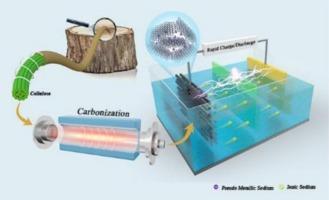Regulating the pseudo graphitic layers to generate closed pores in biomass derived hard carbon anode for ultrafast-charging sodium ion batteries
IF 13.2
1区 工程技术
Q1 ENGINEERING, CHEMICAL
引用次数: 0
Abstract
Biomass-derived hard carbon has emerged as a promising anode material for sodium-ion batteries (SIBs) due to its superior electrochemical performance and low cost. However, the poor initial coulombic efficiency and high-rate performance of hard carbon in SIBs still needs to be improved, especially for the fast-charging demand in the future. Here, we systematically investigate the structural evolution of closed pores and develop a simple two-step method to fabricate high-performance hard carbon from wood pulp. Microstructural analysis reveals that closed pores in hard carbon can be generated from longer and ordered graphitic layers and provide high plateau capacity and superior high-rate property. The optimized hard carbon anode delivers outstanding electrochemical properties: a high reversible capacity of 315.1 mAh g−1 at 0.1C, superior ICE of 90.3 %, and remarkable rate capability (250.8 mAh g−1 at 20C). Experimental analysis and density functional theory (DFT) calculations demonstrated that these closed pores enhance rate performance by improving electronic conductivity and reducing sodium diffusion barriers. Additionally, the excellent electrochemical performance of assembled pouch cells displays the great potential for practical application. This work provides a facile, scalable and cost-effective strategy for producing high performance hard carbon anode materials for fast-charging SIBs.

超快充电钠离子电池用生物质硬碳阳极调节伪石墨层形成闭合孔
生物质硬碳以其优异的电化学性能和低廉的成本成为钠离子电池极具发展前景的负极材料。但是,sib中硬碳的初始库仑效率和高倍率性能仍然需要改进,特别是未来的快速充电需求。在此,我们系统地研究了封闭孔隙的结构演变,并开发了一种简单的两步法从木浆中制备高性能硬碳。显微结构分析表明,长而有序的石墨层可形成封闭孔隙,具有较高的高原容量和优越的高速率性能。优化后的硬碳阳极具有出色的电化学性能:在0.1C时具有315.1 mAh g - 1的高可逆容量,优异的ICE为90.3 %,以及出色的倍率容量(20C时为250.8 mAh g - 1)。实验分析和密度泛函理论(DFT)计算表明,这些封闭孔隙通过提高电子导电性和降低钠扩散屏障来提高速率性能。此外,组装袋状电池的优异电化学性能显示出巨大的实际应用潜力。这项工作为快速充电sib生产高性能硬碳阳极材料提供了一种简便、可扩展和经济高效的策略。
本文章由计算机程序翻译,如有差异,请以英文原文为准。
求助全文
约1分钟内获得全文
求助全文
来源期刊

Chemical Engineering Journal
工程技术-工程:化工
CiteScore
21.70
自引率
9.30%
发文量
6781
审稿时长
2.4 months
期刊介绍:
The Chemical Engineering Journal is an international research journal that invites contributions of original and novel fundamental research. It aims to provide an international platform for presenting original fundamental research, interpretative reviews, and discussions on new developments in chemical engineering. The journal welcomes papers that describe novel theory and its practical application, as well as those that demonstrate the transfer of techniques from other disciplines. It also welcomes reports on carefully conducted experimental work that is soundly interpreted. The main focus of the journal is on original and rigorous research results that have broad significance. The Catalysis section within the Chemical Engineering Journal focuses specifically on Experimental and Theoretical studies in the fields of heterogeneous catalysis, molecular catalysis, and biocatalysis. These studies have industrial impact on various sectors such as chemicals, energy, materials, foods, healthcare, and environmental protection.
 求助内容:
求助内容: 应助结果提醒方式:
应助结果提醒方式:


